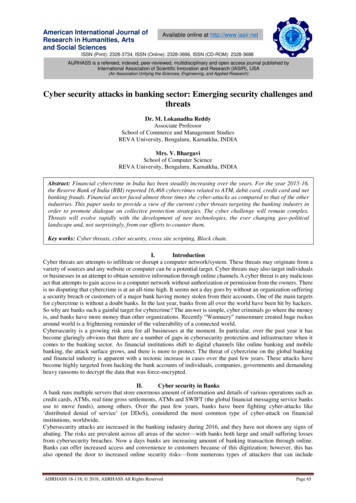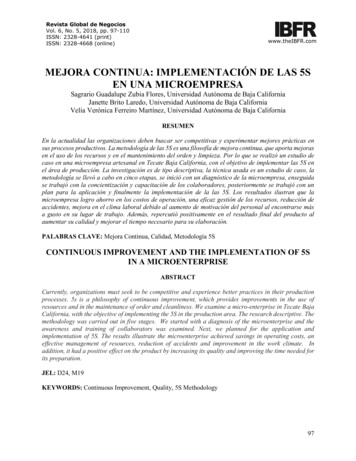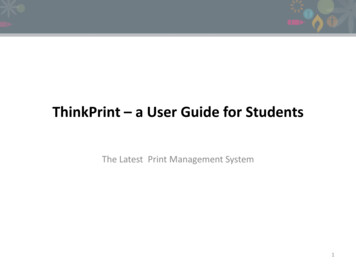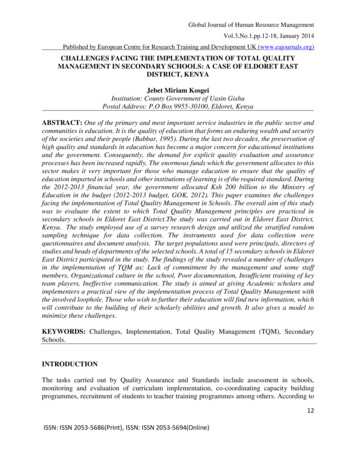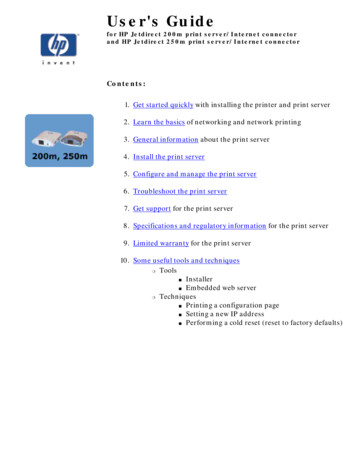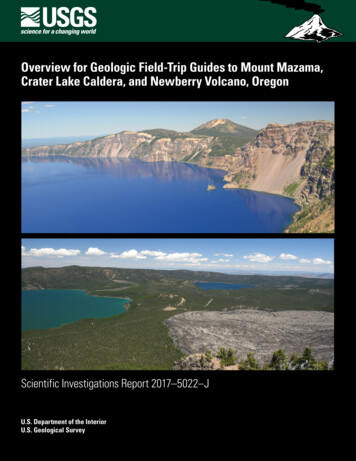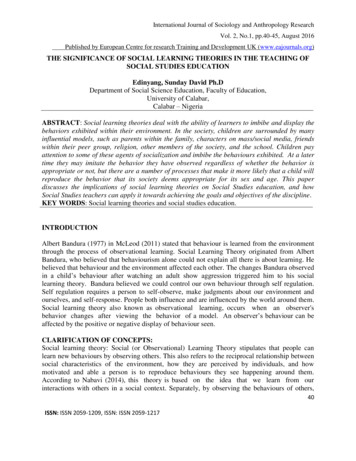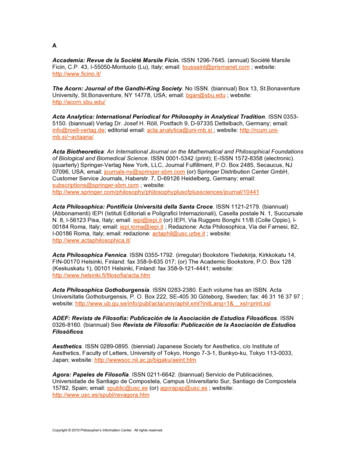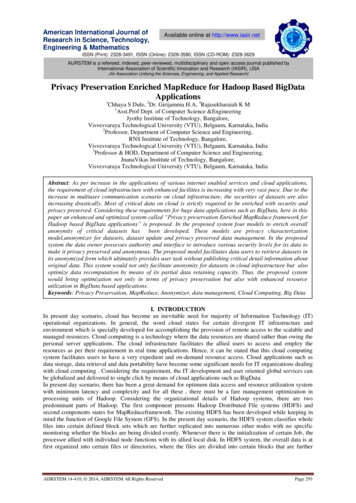
Transcription
American International Journal ofResearch in Science, Technology,Engineering & MathematicsAvailable online at http://www.iasir.netISSN (Print): 2328-3491, ISSN (Online): 2328-3580, ISSN (CD-ROM): 2328-3629AIJRSTEM is a refereed, indexed, peer-reviewed, multidisciplinary and open access journal published byInternational Association of Scientific Innovation and Research (IASIR), USA(An Association Unifying the Sciences, Engineering, and Applied Research)1Privacy Preservation Enriched MapReduce for Hadoop Based BigDataApplications1Chhaya S Dule, 2Dr. Girijamma H.A, 3Rajasekharaiah K M1Asst.Prof Dept. of Computer Science &EngineeringJyothy Institute of Technology, Bangalore,Visvesvaraya Technological University (VTU), Belgaum, Karnataka, India2Professor, Department of Computer Science and Engineering,RNS Institute of Technology, Bangalore,Visvesvaraya Technological University (VTU), Belgaum, Karnataka, India3Professor & HOD, Department of Computer Science and Engineering,JnanaVikas Institute of Technology, Bangalore,Visvesvaraya Technological University (VTU), Belgaum, Karnataka, IndiaAbstract: As per increase in the applications of various internet enabled services and cloud applications,the requirement of cloud infrastructure with enhanced facilities is increasing with very vast pace. Due to theincrease in multiuser communication scenario on cloud infrastructure, the securities of datasets are alsoincreasing drastically. Most of critical data on cloud is strictly required to be enriched with security andprivacy preserved. Considering these requirements for huge data applications such as BigData, here in thispaper an enhanced and optimized system called “Privacy preservation Enriched MapReduce framework forHadoop based BigData applications” is proposed. In the proposed system four models to enrich overallanonymity of critical datasets has been developed. These models are privacy characterizationmodel,anonymizer for datasets, dataset update and privacy preserved data management. In the proposedsystem the data owner possesses authority and interface to introduce various security levels for its data tomake it privacy preserved and anonymous. The proposed model facilitates data users to retrieve datasets inits anonymized form which ultimately provides user task without publishing critical detail information aboutoriginal data. This system would not only facilitate anonymity for datasets in cloud infrastructure but alsooptimize data recomputation by means of its partial data retaining capacity. Thus, the proposed systemwould bring optimization not only in terms of privacy preservation but also with enhanced resourceutilization in BigData based applications.Keywords: Privacy Preservation, MapReduce, Anonymizer, data management, Cloud Computing, Big DataI. INTRODUCTIONIn present day scenario, cloud has become an inevitable need for majority of Information Technology (IT)operational organizations. In general, the word cloud states for certain divergent IT infrastructure andenvironment which is specially developed for accomplishing the provision of remote access to the scalable andmanaged resources. Cloud computing is a technology where the data resources are shared rather than owing thepersonal server applications. The cloud infrastructure facilitates the allied users to access and employ theresources as per their requirement in real time applications. Hence, it can be stated that this cloud computingsystem facilitates users to have a very expedient and on-demand resource access. Cloud applications such asdata storage, data retrieval and data portability have become some significant needs for IT organizations dealingwith cloud computing . Considering the requirement, the IT development and user oriented global services canbe globalized and delivered to single click by means of cloud applications such as BigData.In present day scenario, there has been a great demand for optimum data access and resource utilization systemwith minimum latency and complexity and for all these , there must be a fare management optimization inprocessing units of Hadoop. Considering the organizational details of Hadoop systems, there are twopredominant parts of Hadoop. The first component presents Hadoop Distributed File systems (HDFS) andsecond components states for MapReduceframework. The existing HDFS has been developed while keeping inmind the function of Google File System (GFS). In the present day scenario, the HDFS system classifies wholefiles into certain defined block sets which are further replicated into numerous other nodes with no specificmonitoring whether the blocks are being divided evenly. Whenever there is the initialization of certain Job, theprocessor allied with individual node functions with its allied local disk. In HDFS system, the overall data is atfirst organized into certain files or directories, where the files are divided into certain blocks that are furtherAIJRSTEM 14-410; 2014, AIJRSTEM All Rights ReservedPage 293
Chhaya S Dule et al., American International Journal of Research in Science, Technology, Engineering & Mathematics, 6(3), March-May,2014, pp. 293-299distributed across cluster nodes. The framework MapReduce has been popularized by open-source Hadoopmodel because of its efficiency in exploiting huge data sets.The uniqueness of MapReduce framework is that this approach takes into consideration of handling of datacollections across the multiple nodes and then returns back the single entity results or data sets. On the otherhand this is the factor that ascertains the fault-tolerance which is visible to the developers or programmers. Thus,considering the architectural view of Hadoop for BigData applications, the performance enhancement can beobtained efficiently when focused on MapReduce optimization. In general a MapReduce application iscomprised of three consecutive phases; mapping functions, data partitioning and reduce process. The first stepcalled mapping operates on a series of key pairs and then after processing it generates output pair of key orvalue pairs. The generated pair (key, value) is then processed with reducer with the partitioning function. In thisprocess the key and the complete number of reducers are taken as input which after processing generates out theindex of the reducer to which the subsequent pair (key, value) must be transmitted for performing furtheroperations. In later function the reduce function interact with allied values possessing unique key and then itgenerates the output. In Map phase the system introduces user-oriented logics to the input data while in reducephase the intermediate results are processed and it results as the final reduced data in the form of key/value pairpresentation. This is the matter of fact that the BigData infrastructure and its components encompass numerousdata sets originating or associated with different origins or cloud sources. Since, the privacy susceptible data inmammoth BigData infrastructure can be easily retrieved because of its scattered or distributed nature, thereforein present day applications the requirement of privacy is realized predominantly. In specific need the privacyconcerns are much aggravated in MapReduce of Hadoop framework for its application in BigData. This is thematter of fact the majority of such privacy issues are generic but while considering applications such as BigDatathese issues becomes very critical [1].In order to accomplish the optimum privacy preservation in cloud computing frameworks, the approach of dataanonymization can play a significant role. Then , in case of huge data in cloud infrastructure or BigDataapplications, in order to accomplish optimum function, scalability and efficiency, the system paradigms aremoving towards MapReduce framework of Hadoop model. On the other hand, being a very sensitive part ofHadoop, MapReduce functions for various activities is cloud data processing and in such cases the explorationfor the approaches to achieve optimum privacy preservation with higher efficiency for BigData application,there is still a long exploratory way to come with certain optimum solution. With the similar objective , in thispaper, a robust technique for privacy preservation in MapReduce has been proposed that ensure to deliver a veryflexible and scalable system model functional with dynamic data sets in BigData application scenario.In this proposed system we have considered the development of privacy preservation model at the top ofMapReduce in Hadoop framework, functional as an “anonymization sensitive filter” with a goal to ensuresecurity and privacy of data sets. In this proposed system model, the developed framework at first process forprivacy preservation before the preserved data is processed by MapReduce component of Hadoop model. On theother hand, in this proposed system model, the feasibility for multiple interfaces would be provided to the dataowners so as to specify numerous privacy preservation requirements on the basis of varied privacy models. Inthis proposed system model, as soon as the data owner specifies the privacy requirements, the proposed modelinitiates certain anonymization paradigms of MapReduce components so as to ensure optimum anonymizationof data sets for succeeding task of MapReduce framework. In order to accomplish the optimum Hadoop model,the anonymized data sets would be re-utilized so as to avoid unwanted re-computation of data sets. This featurewould reduce the computational cost resulting into efficient system function. In such robust manner, theproposed system model would not only represent a privacy preservation scheme that can efficiently deals withdynamic data sets in cloud but it would also ensure maintaining of privacy needs of individual dynamic datasets. In this proposed research, in spite of privacy preservation oriented datasets anonymization a parallelscheme for encryption approach has been advocated that ensures a computational cost effective facility formultiple datasets which are anonymized for varied privacy needs individually. Ultimately, an integrated systemmodel has been proposed that integrates developed privacy preservation model with cloud infrastructure forBigData applications. In this proposed system work, we propose to accomplish system’s functional analysis onthe basis of real time data sets so as to evaluate the robustness of the proposed system.Hadoop system is proposed to be developed on Microsoft Azure platform where it would be installed inHDInsight In this proposal the Virtual Machines (VMs) would be generated on CentOS. In this researchproposal, the consideration of HD Insight has been emphasized because it encompasses numerous grids and foraccessing these grids in real time applications it is required to have Hadoop system that is ultimately a cluster ofVirtual Machines in cloud environment.II.RELATED WORKSLiterature survey plays a significant role for building foundation for any research and development. Consideringthese requirements, a security orientated and privacy preservation for cloud infrastructure related survey hasbeen conducted. Some of the predominant works done till are as follows:AIJRSTEM 14-410; 2014, AIJRSTEM All Rights ReservedPage 294
Chhaya S Dule et al., American International Journal of Research in Science, Technology, Engineering & Mathematics, 6(3), March-May,2014, pp. 293-299Sriprasadh, K. et al [2] advocated the security concerns in cloud computing infrastructure and developed anapproach for cloud security with multicast key facility for individual users where users were assigned itsindividual dynamical session key and it is maintained as per user movements. In other work Chang Liu et al [3]advocated the significance for authenticated Key Exchange (AKE) with optimized symmetric-key encryptionfor cloud security and developed hierarchical key exchange scheme Cloud Background Hierarchical KeyExchange (CBHKE), a two-phase multilayered iterative key exchange approach for data security. Qiwei Lu et al[4] advocated that due to data partitioning in cloud infrastructures the collaboration of privacy and security fordistributed data is must. They explored a secure and practical outsourced collaborative data mining approach forcloud and designed a simple framework for security of data sets. Xin Dong et al [5] proposed an effective datacollaboration scheme with security feature called SECO and employed a two-level hierarchical identity basedencryption (HIBE) for ensuring the anonymity of data sets in untrusted cloud infrastructure. Initially theyexplored secure cloud data collaboration service that prevents unwanted leakage of data details and thenfacilitates a one-to-many encryption scheme with data writing and fine-grained access control concurrently. Alight weight software based agent was advocated by El Ahrache, S.I. et al [6] which functions in parallel withthe cloud database on each compassing virtual machines.In other work Taeho Jung etal [7] presented certain scheme in which they facilitated a robust anonymous licensecontrol approach, AnonyControl for addressing data privacy. Rani, A. et al [8] developed Key Insertion andSplay Tree encryption approach that implements an asynchronous key series so as to perform data setsencryption. Ming Li etal [9] developed an approach that could deliver an efficient solution for search schemesfor encrypted cloud storage infrastructures employing symmetric-key encryption techniques. Kumar, A. etal[10] developed system model to perform data storage effectively in the cloud infrastructure and presentedsystem as a model to deal with huge data collections and ensured security using encryption schemes. In [11] asystem model was developed based on encryption techniques functional on the basis of block cipher. Ermakova,T. etal [12] presented an important scheme for secure framework in cloud infrastructure especially designed forhealth care data sharing over cloud. The author designed a multi-provider cloud infrastructure that fulfills needsfor higher resource availability, data privacy and its confidentiality in cloud infrastructure. They employedsecret sharing for distributing various data records across cloud services that facilitates lower redundancy andsupplementary security or privacy protection and performance was analyzed in terms of key compromise,inefficient encryption schemes and at last employed secret-sharing scheme with developed multi-cloudarchitecture. Alvarado et al [13] explored various techniques and analyzed existing security systems in cloudinfrastructures for securing or protecting user data in cloud. Similarly, Ushdia, M. et al [14] proposed a schemewith data aggregation. In this scheme data stored is assured for its authenticated and leakage free storage andsecond need that system considers the provision of a multi-level granularity for the results obtained afteraggregation. Powers, J. et al [15] envisioned a robust and efficient cloud-based data storage model whichfacilitates data owners to share their details in cost effective way even in the case of BigData applications andemployed an iterative approach with Paillier Encryption and a random perturbation approach. Teo, et al [16]developed a protocol for estimating certain malicious party and semi-honest party in cloud infrastructure. In thisresearch work the authors employed Multiplication (FSMP), Secure Scalar Product (SSP), and Secure Inverse ofMatrix Sum (SIMS) paradigms. Jiawei Yuan et al [17] developed one system model for optimizing efficiency ofcloud models by employing scheme for power use in cloud infrastructure. In the proposed model, the authorsadvocated that the individual data owner in cloud performs encryption for its associated private data on localbasis and then uploads encrypted cipher texts into the cloud infrastructure. Then they developed an algorithmthat can process majority of functions while pertaining to the learning paradigms over encrypted cipher textswithout retrieving any information about the private data. In order to facilitate a flexible processing scenarioover encrypted cipher texts the author has considered and tailored the BGN "doubly homomorphic" encryptionscheme that exhibits multiparty setting. Samanthula, et al [18] emphasized on range query scheme andemployed simple security primitive called secure comparison of encrypted integers.This is the matter of fact that a number of researches have been done for ensuring security for data sets orcritical information on cloud infrastructure, but still majority of researches suffers a lot of limitations. Majorityof works do employ data encryption on cloud but it should be noted here that most of computations in cloudcomputing functions with unencrypted datasets. Even for BigData applications, major works are found to beconfined. On the other hand, anonymity approaches and privacy preservation for Hadoop model, which is a keycomponent for BigData applications, has not been considered dominantly. Very few works have been done forprivacy preservation based MapReduce framework for Hadoop based BigData applications. Therefore, in thisresearch proposal a highly robust and efficient privacy preservation model has been proposed that not onlyensures anonymity of original datasets but also provides enhanced data utilization on cloud infrastructure.III.PROPOSED SYSTEM/METHODOLOGIESConsidering the requirement of a highly robust and secured or anonymizedMapReduce framework for HadoopModel to be employed with BigData applications, here in this paper a novel technique called PrivacyPreservation Enriched MapReduce framework for Hadoop based BigData applications has been proposed.AIJRSTEM 14-410; 2014, AIJRSTEM All Rights ReservedPage 295
Chhaya S Dule et al., American International Journal of Research in Science, Technology, Engineering & Mathematics, 6(3), March-May,2014, pp. 293-299In order to preserve the security concerns associated with datasets in cloud infrastructure, here in this paper weproposed a MapReduce optimization technique called Privacy preserved MapReduce which functions inbetween the genuine datasets and user specified tasks for MapReduce framework. This user specified tasks arenothing else but the retrieval of certain data sensitive details or information from distributed cloud network.Tentative system architecture has been proposed as follows.DatasetsDatasets OwnerPrivileges andAccessing PoliciesMapFunctionMapFunction.Original ionMapTasks assigned by lored ResultsFunctionProposed Privacy PreservingModelConventionalMapReduce layersFigure: 1 Enhanced Privacy Preserved MapReduce framework for Hadoop based BigData applicationsConsidering the above mentioned architecture, it can be found that in the proposed model, the authenticated,critical and owner uploaded original data is uploaded with confidentiality and no data user would be able toretrieve the critical data of data owner. This proposal facilitates an interface for data owner to introduce itsaccess policies to data users. The owner of data specifies certain policies for its privacy preservation. In spite ofthis in this paper, a scheme of data anonymizationwill be provided which functions as per privacy preservingpolicies it need. In order to minimize the recomputation of data sets in MapReduce function, some of theanonymized datasets are preserved. This facilitates the system to function as a data store management toolwhich can further update new data sets in cloud.As per normal user function, the data users can specify their application needs as a job to the Hadoop and thenthrough HDFS to MapReduce, and there runs their job on certain processed anonymized datasets. In theproposed system model, the privacy preservation scheme proposed, exhibits exploitation of jobs assigned toMapReduce framework for performing the required computations for data anonymization. This is the matter offact that in BigData applications, there are huge data sets and even more complicated relationships amongdatasets; therefore it becomes significant to perform anonymized computation in MapReduce so as to preserveprivacy of data sets on cloud storage.Anonymizerfor DatasetsDataset UpdateMapReduce of Hadoop ModelPrivacy preserved DatamanagementCloud Computing InfrastructurePrivacy Characterization ModelFigure: 2 proposed system sequential development and functional designIn order to accomplish the goal of privacy preserved model with enhanced system scalability and optimizedperformance for Hadoop framework in BigData applications here in this paper certain tentative models has beendefined which can optimize overall performance of Hadoop model (especially for MapReduce) to ensureprivacy preservation in cloud infrastructure. These tentative and defined components are:1.Privacy Characterization Model2.Anonymizer for Datasets3.Dataset Update4.Privacy preserved Data managementAIJRSTEM 14-410; 2014, AIJRSTEM All Rights ReservedPage 296
Chhaya S Dule et al., American International Journal of Research in Science, Technology, Engineering & Mathematics, 6(3), March-May,2014, pp. 293-299These defined system components can enhance overall system with four different issues, which canrevolutionaries’ to increase the efficiency of Hadoop or MapReduce framework for BigData applications.In proposed system model, the predominant components are Anonymizer for Datasets, dataset update andprivacy preserved data management that function significant roles. In fact these proposed system moduleswould exhibit important function for ensuring privacy preservation as proposed for first module called privacycharacterization scheme. Once the datasets have been processed with MapReduce, the updated data would bethen processed for updates. In the last component of the proposed system, called privacy preserved datamanagement; the emphasis would be made on ordering of the datasets so as to reduce the re-computation ofdatasets. In such way, this component would facilitate the utilization of cloud resources straightforwardly forachieving user specific task. The proposed research would facilitate enhancements for MapReduce componentby introducing MapReduce framework at the top level of cloud that would ultimately achieve better systemscalability and flexibility for real time applications, especially for BigData applications.A brief of the tentative system components to be developed has been discussed as follows:A.PRIVACY CHARACTERIZATION MODELIn this proposed research, it has been tried to accomplish the goal of a highly scalable and well mechanizedcloud model enriched with privacy concerns while assuring datasets genuinity in BigData applications.The first and important module is privacy characterization model that provide significant characterization ofdifferent requirement so as to facilitate an interface for data owner for introducing its required privacy issues.The need for security as characterized by data owner is characterized by certain factors, such as the privacymodule. In this tentative system the privacy module being proposed could be a k-anonymity or t-closeness. Theconsidered approach of k-anonymity based privacy preservation would facilitate multiple level of preservation.Being considered model the k-anonymity states that records or data sets being anonymized which are associatedwith certain quasi identifier must be higher than certain defined threshold parameter. In case of a specificscenario, when some of the quasi-identifiers becomes much specified that it is associated with very little usersthen in this case the associated users could be assigned authority for accessing higher confidential data and itmight cause the breaching of security level. In the proposed system model, the quasi-identifiers state certaincollections of anonymized datasets. On the basis of k-connectivity or t-closeness privacy model, in this tentativeresearch paper, it has been tried to make quasi-identifiers more than the specified thresholds. The considerationof t-closeness can also ensure the distribution of certain critical datasets which are very close to the originaldatasets, associated with quasi-identifiers.In the proposed model, the data owners would be facilitated with their own specification for data anonymizationwhile exhibiting data classification and its clustering. Even without knowing the application types, the secondcomponent of the proposed model, Anonymizing of data can generate anonymized datasets for general usesexpected from users. The characterization must be significant because, in case of our proposed BigDataapplication, in fact all the original datasets are used directly these days, but for data anonymization only certainsegments of data attributes are employed. In spite of this the data owner can also be provided a facility to assignabstraction for data usefulness or exposure to users. Abstraction based facility would enhance our proposedsystem with the flexibility of data anonymization.B.ANONYMIZER FOR DATASETSConsidering an approach of anonymization, a well justified approach comes into mind and it is nothing else butthe “Generalization”. This approach states that a parent domain parameter or entity can be substituted with itsdescendant’s or child domain entities so as to preserve privacy in its domain taxonomy tree. The datasuppression in this approach can effectively substitute the original owner data with certain pre-specified symbolthat would ultimately hide all the details of that specific data entity. This model would play a vital role indistinguishing the attribute parameters and certain critical parameters without causing any changes ormanipulation in those parameters or attributes.In the proposed system model, certain generalization approaches can be taken into consideration such as fulldomain [19], sub-tree [20], multi-dimensional [21] and cell [22]. This is the matter of fact that thesegeneralization schemes have exhibited better but when considering applications such as BigData, thegeneralization approach like multi-dimensional and cell generalization are forced to suffer a lot due to dataexploration issues and inconsistency. Most of the existing schemes are insufficient for BigData applicationsbecause of data placements in varied computation nodes. Therefore in this research the MapReduce basedmechanism is considered. In order to achieve better results it would be tried to implement Map and Reduce initerative fashion, because of iterative anonymization in proposed modeling function. In the proposed systemmodel, algorithms for privacy preserved MapReduce would be developed for Hadoop in BigData applications. Itwould play a vital role in assuring data anonymity.AIJRSTEM 14-410; 2014, AIJRSTEM All Rights ReservedPage 297
Chhaya S Dule et al., American International Journal of Research in Science, Technology, Engineering & Mathematics, 6(3), March-May,2014, pp. 293-299C.DATASET UPDATEIn order to facilitate data access to various data users as per their application needs, it is needed to provideprivileges in certain secure way and therefore in cloud infrastructure, it is always required to generate datasetsand update anonymized data sets for users. Then while, the critical data sets on cloud infrastructure might varyover time and this is very common in BigData applications. Therefore, in this proposed system work, certainmodel would be developed for updating original datasets and anonymized data sets as per privacy concerns.Here, systems would be developed in such a way that it might anonymize the datasets of updated parts. In thisphase varied anonymization layer would be employed for accomplishing privacy preservation and it would betried to regulate the level of anonymization across the anonymized data sets. In this system we would try tobring optimum data utilization by users.D.PRIVACY PRESERVED DATA MANAGEMENTIn order to optimize overall performance and computational efficiency a scheme for data retaining can beadvocated for reutilizing the datasets. A data attribution scheme [23] can be considered for managing datasets.The regenerative nature of data attribution might facilitate regeneration of dataset from its antecedent datasets. Itavoids regeneration of datasets. In the proposed model, the implementation of privacy characterization modulemay facilitate easy characterization of various privacy concerns and a dataset would be anonymized into variousanonymous data. This would make system potential for recovering privacy sensitive details from numerousanonymous datasets. To achieve this issue for BigData applications, a system model can be advocated usingencryption to ensure privacy preservation for all anonymous datasets that can be further shared among datausers. Since, the encryption on all datasets can cause the huge overheads because of recurrent uses by data users,in this research , we would try to encrypt a definite part of datasets that might enhance privacy preservation withoptimized computation cost. A paradigm [24] can be explored for enhancement by our proposed approachwhere certain selective data would be ][11][12][13][14][15][16][17][18]Chaudhuri S (2012) What next?: A half-dozen data management research goals for big data and the cloud. In: Proceedings ofthe 31st symposium on principles of database systems , pp 1–4Sriprasadh, K.; Saicharansrinivasan; Pandithurai, O.; Saravanan, A., "A novel method to secure cloud computing throughmulticast key management," Information Communication and Embedded Systems (ICICES), 2013 International Conferenceon 21-22 Feb. 2013, pp.305-311.Chang Liu; Xuyun Zhang; Chengfei Liu; Yun Yang; Ranjan, R.; Georgakopoulos, D.; Jinjun Chen, "An Iterative HierarchicalKey Exchange Scheme for Secure Scheduling of Big Data Applications in Cloud Computing,"
Hadoop, MapReduce functions for various activities is cloud data processing and in such cases the exploration . facilitates a one-to-many encryption scheme with data writing and fine-grained access control concurrently. A light weight software based agent was advocated by El Ahrache, S.I. et al [6] which functions in parallel with .
